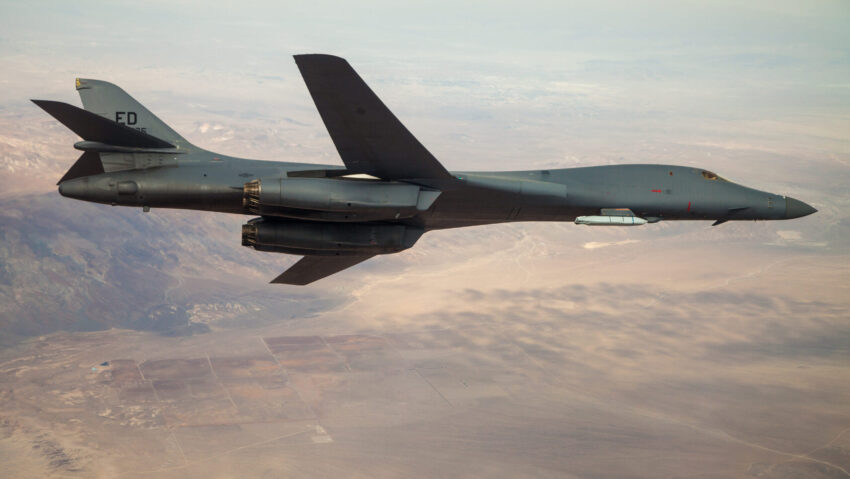A B-1B Lancer with a Joint Air-to-Surface Standoff Missile (JASSM) flies in the skies above Edwards Air Force Base, California, Nov. 20, 2020. (Air Force photo by Ethan Wagner)
WASHINGTON — The US Air Force is seeking an additional $10 billion in funding in fiscal 2026 to supercharge munitions production, boost fleet readiness and carry forward construction projects that were not included in the service’s budget request, according to an unfunded priorities list (UPL) submitted to Congress and obtained by Breaking Defense.
The Space Force would also seek nearly $6 billion for its own unfunded priorities, ranging from a new satellite constellation to several classified projects, a separate UPL also obtained by Breaking Defense shows.
Required by law to be submitted annually after the Pentagon’s budget request is formally unveiled, the UPLs from the Air Force and Space Force this year reflect sharp increases compared to those submitted last year, where the services respectively requested $3.5 billion and $1.15 billion. They also follow lawmakers’ passage of an extra $150 billion in defense spending as part of a reconciliation package passed last week, which could result in the Defense Department’s first trillion-dollar budget.
Of the $9.95 billion requested by the Air Force’s UPL, the largest chunk of cash — approximately $4.15 billion — would be dedicated to maximizing production for a range of munitions, including traditional weapons like AMRAAM, a new, longer-range air-to-air missile called JATM, a revived hypersonic missile dubbed ARRW and a more cost-effective, laser-guided rocket interceptor known as the APKWS II, which has been used by US forces to knock down Houthi drones in the Red Sea.
While most of the specific details underlying each munitions request is excluded due to classification, the document does explain the separate requests for the air-to-air AMRAAM and ship-killer LRASM, which shares a common airframe with the JASSM missile used against land-based targets. According to the UPL, $738 million for AMRAAM would be able to expand the weapon’s production to ,2400 rounds annually by FY28 and address obsolescence issues, whereas $800 million for LRASM/JASSM would double production from 1,100 to 2,200 rounds per year by FY30. The Air Force would use $200 million of that $800 million pot to secure a second engine source, the document says.
The second biggest bucket of spending, roughly $1.98 billion, would be used to improve aircraft readiness, which has suffered in recent years as Air Force fleets have aged and shrunk in quantity. The service would allocate $1.51 billion to buy more spare parts, while separately reserving $221.9 million to fund depot activation, equipment and other features for the KC-46 refueler. Remaining funds in the readiness category would go toward C-130J improvements, while $8 million would be used to connect the VIP airlift C-37 fleet to the Starlink communications network.
The remainder of the Air Force’s UPL request would fund a series of projects, including $1.73 billion for military construction work and $1.42 billion for facility sustainment. An additional $334.3 million would further support theater campaigning and regional exercises, including in the INDOPACOM and USSOUTHCOM regions, the UPL says.
Space Force: Moving Ahead With MILNET
Leading the Space Force’s $5.98 billion UPL is the service’s nascent MILNET satellite constellation project, where roughly $3.53 billion would be set aside to fund the effort’s “Block II” work and an additional $686.8 million would furnish Block II satellite launches.
Largely secret until recently revealed by Space Force officials and lawmakers, the MILNET project is headed by Elon Musk’s SpaceX and is expected to consist of hundreds of government-owned, contractor operated satellites. In a recent hearing on Capitol Hill, members of Congress like Sen. Chris Coons, a Delaware Democrat, said the MILNET program is slated to replace an ongoing effort led by the Space Development Agency that is building out a global data relay satellite network with multiple vendors in the mix.
While Space Force officials have said how MILNET will be fielded is still under consideration, a multibillion-dollar request for Block II work, along with hundreds of millions of dollars for satellite Block II launches, could suggest that the MILNET endeavor is farther along than publicly known. The UPL says the Block II funding “[c]loses critical capability gaps and provides increased coverage in contested environments,” whereas the space launch funding “[l]aunches purchased MILNET Block II satellites.”
RELATED: Space Force ponders shakeup to LEO satellite strategy, potentially hiring SpaceX for data relay
Beyond the MILNET project, the Space Force would seek about $1.61 billion to spread across three classified programs. Other dollars would go toward addressing obsolescence issues with GPS ground antennas, modernizing ground stations and sustaining facilities, according to the service’s UPL.
Rounding out aerospace-related requests is US Space Command, which is seeking an additional $2.5 billion for its own unfunded priorities — double last year’s request of $1.2 billion. However, the contents of SPACECOM FY26 request are designated either as classified or controlled unclassified information.
Click this link for the original source of this article.
Author: Michael Marrow and Valerie Insinna
This content is courtesy of, and owned and copyrighted by, https://breakingdefense.com and its author. This content is made available by use of the public RSS feed offered by the host site and is used for educational purposes only. If you are the author or represent the host site and would like this content removed now and in the future, please contact USSANews.com using the email address in the Contact page found in the website menu.








